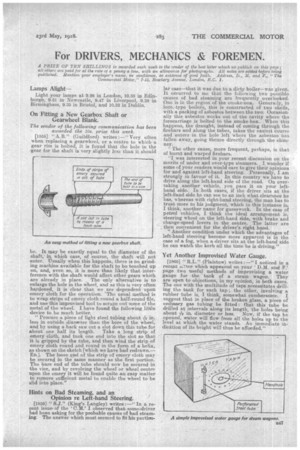For DRIVERS, MECHANICS & FOREMEN.
Page 21

If you've noticed an error in this article please click here to report it so we can fix it.
Lamps Alight---
Light your lamps at 9.26 in London, 10.33 in Edinburgh, 9.51 in Newcastle, 9.47 in Liverpool, 9.38 in Birmingham, 9.35 in Bristol; and 10.32 in Dublin.
On Fitting a New Gearbox Shaft or Gearwheel Blank.
The sender of the following communication has been awarded the lOs. prize this week.
[1858] "A.B." (Guildford) writes :—" Very often when replacing a gearwheel, or a centre to which a gear rim is bolted it is found that the hole in the -gear for the shaft is very slightly less than it should be. It may be exactly equal to the diameter of the shaft, in, which case, of course, the shaft will not enter. Usually when this happens, there is no grinding machine available for the shaft to be touched up on, and, even so, it is more than likely that interference with the shaft would affect other gears which
are already in place. The only alternative is to enlarge the hole in the Wheel, and as this is very often hardened, it is clear that we are dependent upon emery cloth for the operation. 'The usual method is to wrap strips of emery cloth round a half-round file, and IMO this improvised tool to scrape outcome of the metal of the wheel. I have found the following little device to be much better.
" Procure a piece of light steel tubing about lie in. less in outside diameter than the bore of the wheel, and by using a hack saw cut a slot down this tube for about one half its length. Take a long strip of emery cloth, and tuck one end into the slot so that it is gripped by the tube, and then wind the strip of• emery cloth round and round in the form of a helix, as shown on the sketch [which we have had redrawn.— En.]. The loose end of the strip of emery cloth may be secured in the same manner as the first portion. The bare end of the tube should now be secured in the vice, and by revolving the wheel or wheel centre upon the emery it will be found quite an, easy matter to remove sufficient metal to enable the wheel to be slid into place."
Hints on Bad Steaming, and an Opinion re Left-hand Steering.
[1859] " S.J." (King's Langley) writes-:—" In a recent issue. of the C.M.' I observed that, some rdriver had been asking for the probable causes of bad steaming. The answer which most seemed to fit his particu
lar case—that it was due to a dirty boiler—was given. It occurred to me that the following two possible causes of bad steaming are frequently overlooked. One is in the region of the smoke-box. Genera,ly, in loco.-type boilers, this is constructed of two shells, with a packing of asbestos between the two. Occasion. ally this asbestos works out of the cavity where the forecarriage is bolted to the smoke-box. When this happens, the draught, instead of coming through the firebars and along the tubes, takes the easiest course and enters in the hole left where the asbestos has fallen away, going thence directly through the chininey.
" The other cause' more frequent, perhaps, is that of burnt and warped firebars.
"I was interested in your recent discussion on the merits of under and over-type steamers. I wonder if some of your readers would care to give their opinions for and against left-hand steering. Personally, I am strongly in favour of it. In this country we have to drive along the left-hand side of the road. On overtaking another vehicle, you pass it on your lefthand side. In both cases, if the driver sits at the left-hand side he can see to an inch what clearance he has, whereas with right-hand steering, the man has to trust more to his judgment, which in this instance is, I think, another name for guesswork. In the case of petrol vehicles, I think the ideal arrangement is, steering wheel on the left-hand side, with brake and change-speed levers in the centre. The latter are then convenient for the driver's right hand.
"Another condition under which the advantages of left-hand steering become more apparent is in the case of a fog, when a driver sits at the left-hand side he can watch the kerb all the time he is driving."
Yet Another Improvised Water Gauge. • [186o1 " ILL." (Plaistow) writes : —" I noticed in a reeelit it:Iter which appeared on your D.11,1. and F.' page two useful methods of improvising a water gauge for the tank of a steam wagon. They are open to objections, in my opinion, in both cases. The one with the multitude of taps necessitates drilling the tank for each tap; the other, involving a rubber tube is, I think, somewhat cumbersome. I suggest that in place of the broken glass a piece of ordinary gas tubing he fitted : that this tube be drilled at intervals along its length, the boles being about -Ain. diameter or less. Now, if the tap be opened, Water will flow from all the holes up to the level at which the water stands. An immediate indiczition of its height will thus be afforded."






















